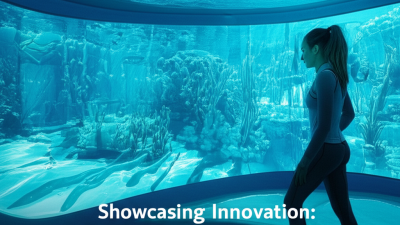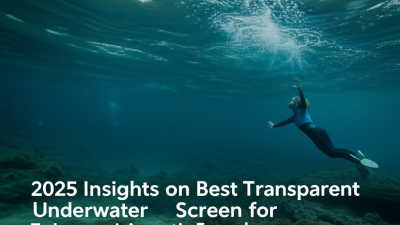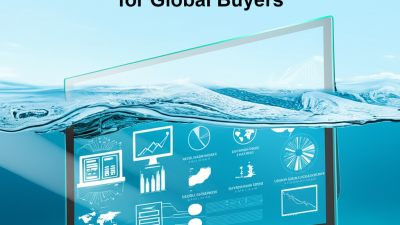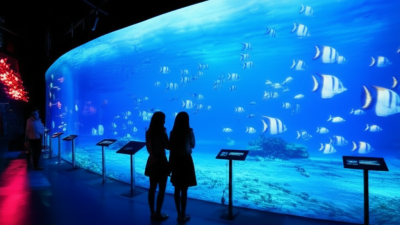
-
Home
-
Products
-
About Us
-
Case
-
News
-
BLOG
-
FAQ
-
Contact Us
Leave Your Message

The advent of Transparent Underwater Screen technology is poised to revolutionize the way we explore and understand our oceans. As mankind continues to face pressing environmental challenges and seeks to unlock the mysteries of the marine world, this innovative technology provides a unique solution that merges vision with function. By allowing researchers and enthusiasts alike to observe underwater ecosystems without disturbing them, Transparent Underwater Screens create immersive experiences that enhance both educational and scientific pursuits.

In this article, we will delve into the intricacies of Transparent Underwater Screen technology, exploring its design, functionality, and potential applications. We will also discuss how this groundbreaking advancement can foster a deeper appreciation of oceanic environments, ultimately promoting conservation efforts and inspiring future generations to engage in sustainable ocean exploration.
The emergence of transparent underwater screen technology is poised to revolutionize ocean exploration. A recent comprehensive scientific expedition underscored this advancement, featuring innovative submersibles designed to operate at depths of up to 10,000 meters. This groundbreaking technology, capable of providing real-time visual feedback from the ocean's depths, enhances our ability to monitor marine environments and collect vital data for research. Studies indicate that over 80% of the world's oceans remain unexplored, and tools that allow for unprecedented visibility will significantly aid in marine conservation efforts and ecosystem management.
The integration of transparent screens in underwater vehicles allows scientists to not only navigate through murky waters but also capture high-definition footage of marine life and underwater landscapes. According to industry reports, the oceanographic instrument market is expected to reach approximately $4 billion by 2025, with advanced imaging and exploration technologies leading this growth. As we harness transparent underwater screen technology, we can expect not only an increase in exploratory missions but also a greater understanding of oceanic ecosystems, ultimately driving initiatives aimed at preserving our planet's vital marine resources.
The advent of transparent underwater screen technology is poised to significantly enhance marine research and interaction. Digital interfaces in underwater environments not only allow researchers to visualize and analyze complex data in real-time but also facilitate a deeper engagement with marine ecosystems. According to a report by the Ocean Exploration Trust, the ability to observe marine life without traditional barriers can lead to more accurate behavioral studies and data collection, ultimately fostering a better understanding of oceanic processes. This revolutionary method can increase the precision of underwater surveys, potentially improving biodiversity assessments by up to 30%.
Tips for effective use of transparent underwater screens include ensuring proper calibration before deployment to maximize data accuracy. Additionally, utilizing real-time feedback mechanisms can enhance interactive experiences, allowing researchers to adjust their approach based on immediate observations.
Furthermore, integrating augmented reality features within these digital interfaces can create immersive educational experiences for students and enthusiasts alike. The Pew Charitable Trusts reported that engaging younger generations through innovative technologies can increase interest in marine conservation efforts by 50%. By harnessing the power of transparent screens, the ocean exploration community can not only advance scientific research but also inspire meaningful connections with the marine environment.
The innovative implementation of transparent underwater screen technology represents a significant breakthrough in environmental monitoring. These advanced screens allow researchers to observe marine ecosystems in real-time without disturbing the wildlife. By employing high-resolution displays integrated with sensors, scientists can monitor changes in water quality, temperature, and biological activity from various depths, providing crucial data for conservation efforts.
One of the key applications of these underwater screens is their ability to visualize the impacts of pollution and climate change on marine life. By projecting information on the screens, researchers can create immersive environments that reveal the behavior of fish and other marine organisms in response to environmental stressors. This technology fosters greater public awareness and understanding of the delicate balance within ocean ecosystems, driving initiatives aimed at preserving biodiversity and restoring habitats.
With such capabilities, transparent underwater screens will play a transformative role in promoting sustainable practices and informing policy decisions related to ocean conservation.
The advent of transparent underwater screen technology is poised to transform ocean exploration, yet several challenges must be addressed to maximize its potential in oceanography. One significant obstacle is the durability of these displays in harsh marine environments. Studies indicate that failure rates of electronic equipment in underwater conditions can exceed 30% within the first year of deployment (Marine Electronics Industry Report, 2023). Therefore, developing robust materials and protective coatings is essential for ensuring longevity and reliability in varying pressures and temperatures.
Additionally, the integration of transparent displays with existing marine technology poses another challenge. The need for real-time data visualization demands high connectivity and processing speeds. Current advancements in underwater communication systems suggest that maximum data transfer rates are only around 1-2 Mbps (Ocean Communication Technologies 2023), which may limit the functionality of transparent screens. Overcoming these technical barriers will be crucial for marine researchers and explorers to fully leverage transparent displays in visualizing and interpreting oceanographic data, ultimately enhancing our understanding of underwater ecosystems.
The integration of smart technologies with underwater screen solutions marks a significant advancement in ocean exploration. With the emergence of new geospatial technology, we now have the ability to organize and interpret marine Big Data more effectively than ever. This innovation creates a centralized repository for managing vast amounts of oceanographic information, allowing researchers and explorers to visualize data in real-time through transparent underwater screens. Such visualization transforms complex datasets into intuitive displays, enhancing decision-making processes in marine research and conservation.
Moreover, the incorporation of intelligent modeling tools and drones into marine exploration facilitates precise data collection and analysis. These technologies work synergistically, enabling the development of advanced mapping techniques and modeling scenarios that were previously unimaginable. As the digital landscape continues to evolve, the potential for underwater screens combined with cutting-edge data visualization tools will undoubtedly revolutionize our understanding of oceanic ecosystems and their dynamics. This technological synergy not only streamlines data interpretation but also opens new avenues for sustainable marine management and exploration.
| Technology | Application | Data Visualization Method | Advantages | Environmental Impact |
|---|---|---|---|---|
| Transparent Underwater Screens | Marine Research | Real-time Data Streams | Enhanced Visibility | Minimal Ecological Disruption |
| AR Integration | Diving Education | Interactive 3D Models | Engaging Learning Experience | Promotes Conservation Awareness |
| Sonar Data Overlay | Submarine Navigation | Visual Mapping | Improved Safety | Reduces Collision Risks |
| Data Analytics Integration | Environmental Monitoring | Predictive Analytics | Proactive Conservation Strategies | Supports Biodiversity Preservation |





